A group of likeminded
who from time to time venture out into and explore the beautiful Overberg region (PAGE






An effort to record as many species within a designated location and time period as possible (PAGE

PLATBOS FOREST
One
the few
(PAGE
The Stanford Spectator20 OCTOBER 2022 - 12-Hour Service - 24-Hour Service - Half Day Service - Wellness Pop-In - Shop-Stop ServiceSERVICE PACKAGES NOW AVAILABLE REPLACING THE STANFORD NEWS ISSUE 04 20 OCTOBER 2022 R25 the STANFORD people, news & what sets us apart
individuals
5)
8)
of
surviving indigenous forests in South Africa filled with ancient trees
10) THE ‘EXPLORERS’ GREAT SOUTHERN
BIOBLITZ
Top: The Helderstroom boys living their best life. (PAGE 3)
NAVIGATING CHALLENGING TIMES
Not only are we living through some challeng ing times, but we are also living in a village where the demographics and geography are rapidly changing. There’s a new energy about the place, new thinking and new plans. Our function at Stanford News Agency is to not only celebrate and enjoy the endeavours of the community, of which there are many, but to also raise awareness of things that are important to those who live and visit our
little piece of paradise. You will find that this latest issue has a distinct spring feel to it, with farming, flowers, and animals at the forefront - plus some stories of hope and friendship.
Virtually yours,
CONTACT US
LIZ CLARKE Publishing Editor
Articles | Photography | Reporting 060 627 9644
liz@stanfordnewsagency.co.za

LizMELISSA MC ALPINE Communications Director
Advertising | Marketing | Social Media 078 324 5692
melissa@stanfordnewsagency.co.za
www.stanfordnewsagency.co.za

The Stanford Spectator is proudly brought to you by the Stanford News Agency
Disclaimer: Great care has been taken in the preparation of this publication. However, Stanford News Agency cannot accept responsibility for any errors which may inadvertently have occurred. The opinions expressed herein are those of the authors and/or persons interviewed, and do not necessarily reflect the views and values of Stanford News Agency. Any comments, suggestions or complaints may be forwarded to liz@stanfordnewsagency.co.za or melissa@stanfordnewsagency.co.za.
The Stanford Spectator is a bi-monthly online publication that comes out on the 1st and 3rd Thursday of every month. Advertisements to reach us by no later than the Friday before the next issue is due to be released.
To place an advertisement, please contact: Melissa Mc Alpine – 078 324 5692 / melissa@stanfordnewsagency.co.za
Back by popular demand!
Coffee Corner in Stanford is up and running again, with Peter and Maureen back at the helm. The coffee shop, situated on the corner of Mor ton and Daneel Streets, is open Mon days to Fridays from 08:00-16:00, with a range of excellent coffees to choose from as well as delectable light bites. Business professionals will be pleased to hear that a private boardroom is also available for meetings. Watch this space for co-working desks with fast WiFi. Coming soon!

Contact Peter on 082 449 7496.

2 The Stanford Spectator FROM THE EDITOR’S DESK
WHAT’S NEW?
Some adorable facesPOPPING UP IN STANFORD
“They are delightful, comical, and noble all rolled into one beautiful furry animal!”
Writer: Alison Notley
Alpacas first came to South Africa in the ear ly 2000s and I am happy to report at least three groups of alpacas now grace proper ties in beautiful Stanford.
The smallest member of the "new world" camelid family - the others being guanaco, llama and vicuna - the alpaca produces the most fleece.

The alpaca is the longest domesticated animal in the world and dates back ten thou sand years to Inca times. Its history is long, tragic, and steeped in local folklore. During the Spanish Conquest in the 1500s hundreds of thousands of Inca people were put to the sword and alpaca herds were killed in their thousands. Some fled to the higher altitudes while others died from hitherto unknown diseases brought to South America with the introduction of sheep and cattle.
It was the brainchild of a retired South African dentist, Dr Gavin Lindhorst, who while holidaying in South America found himself smitten by the charm of alpacas and later embarked on a selection process from various sources, mostly in Chile, to make their way via Malaysian Airlines to South Africa in 2001.
With approximately 120 alpacas newly arrived on African soil, they were dispatched to new homes around the country and one of those was our own. Our start-up pack consisted of five pregnant females.
Alpacas are rare in the world. Peru boasts 95 per cent of the world's alpacas with a population of around 3.5 million. Alpacas are also abundant in Chile and Bolivia. They are not an endangered species, and they live in the high altitudes of the Andean Altiplano above the tree line. They are the most co lour-diversified fleece-bearing animal in the world with over 22 classifications of colours and shades.
They are now worldwide - North America, the United Kingdom and all over Europe, Australia, New Zealand and South Africa.
Not long ago, Australia exported two lots of 500 alpacas to China. Alpacas appear to have adapted well to different terrain at all sorts of altitudes.
Although they are a most biddable animal, they have unfortunately gained the reputa tion of being spitters. Well, they are camels, and this is what camels do. Spitting is their defense mechanism, but you really have to rattle them before you get a face full! It is only masticated vegetation but neverthe less it is green, smelly, fast and extremely accurate!
We will be shearing our herd at the end of October when we will need to restrain the animals gently but firmly and avoid being spat at or kicked. We use electric shears, and everyone needs to be safe.
We wean our youngsters between five and six months of age and this is the time they begin their halter training. This can be huge fun teaching the young cria (Spanish for young one) to lead from a headcollar. This discipline pays dividends later when they need to stand for a vet or for toenail trimming.
Alpacas’ fibre is considered one of the finest animal fibres on the planet and is used in the manufacture of high-end fabrics, turned into soft and durable felt or spun into yarn and used for items of knitwear. This is done on a commercial basis in South America where they can draw on huge resources whereas in most other parts of the world it is considered more an upmarket cottage industry. There are many alpaca owners in South Africa making items of clothing with alpaca fibre and one of these expert craftswomen has very recently moved to Stanford.
Please don't go looking for an alpaca to keep your lawn mown. Alpacas are herd animals and do not thrive singly. Minimum herds of three same-sexed animals are recommended. They are delightful, comical, and noble all rolled into one beautiful furry animal!
Top: Peter, the family favourite.
Bottom: A jersey made from alpaca wool.

3 The Stanford Spectator20 OCTOBER 2022
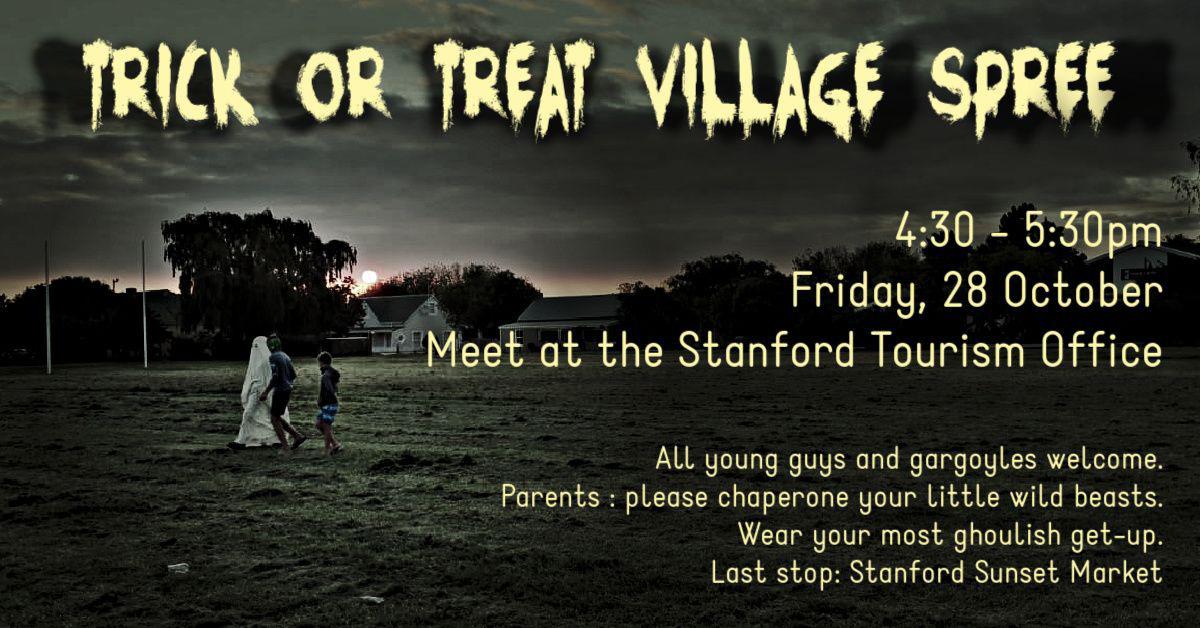
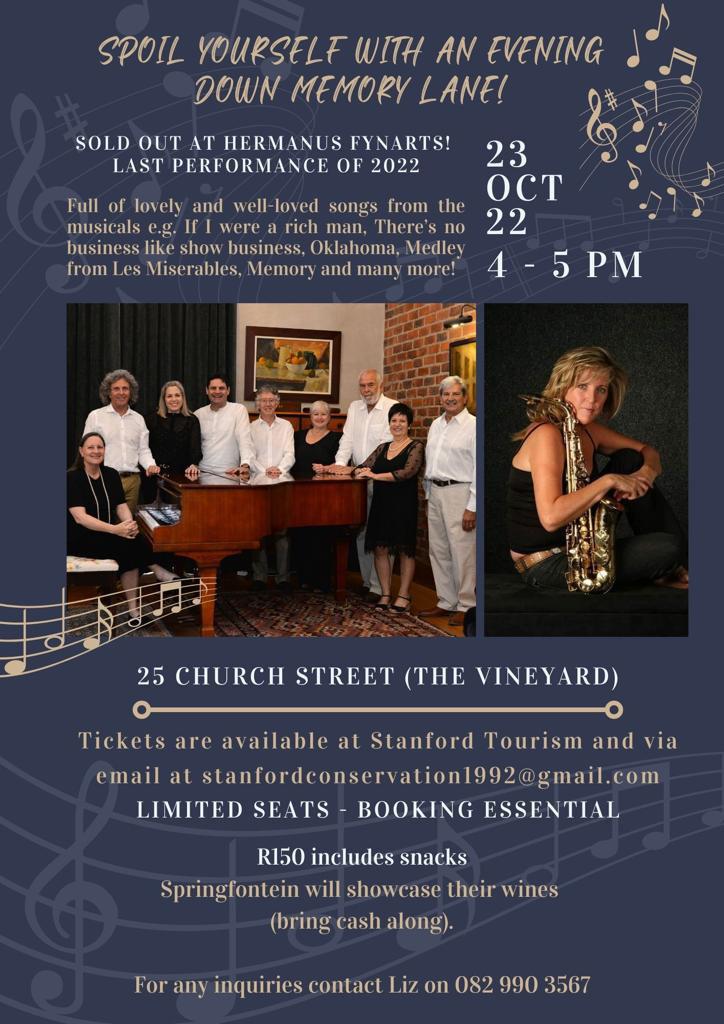


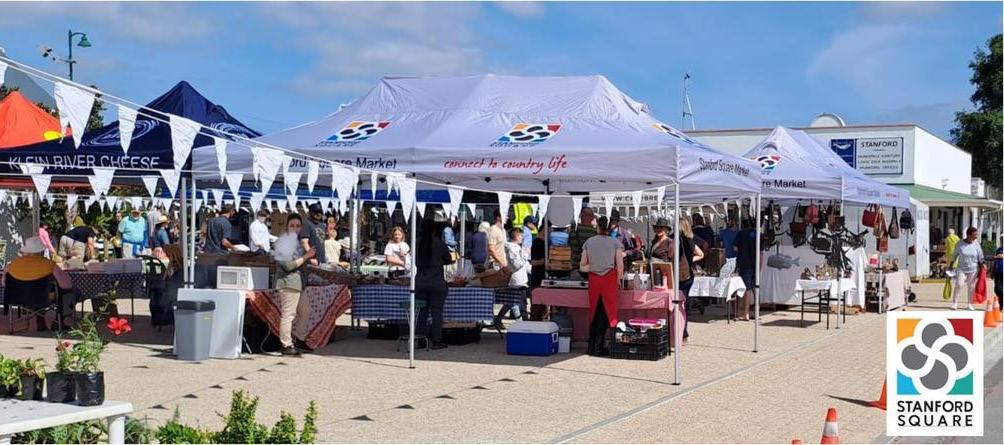

4 The Stanford Spectator 20 OCTOBER 2022 DATES TO DIARISE Every Monday Painting Classes with Tracy Algar R200 Egret & The Owl Book Café Every Saturday Stanford Square Market (9am – 2pm) Stanford Square (Centre of town) Details: Kathryn Stanford Saturday Morning Market (9am – 12pm) Stanford Hotel Stoep WEEKLY EVENTS DATES TO DIARISE OCTOBER 20 Quiz Night at The Zesty Lemon (6pm) R50 entry fee Booking essential: 028 341 0647 / 072 412 6017 23 Music Concert (25 Church Street, Stanford) Details: Liz 082 990 3567 26 Explore the Landscape in Charcoal Stanford Hills Estate (09h00 – 12h00) Details: Marlene 083 254 2902 27 Think & Drink (6.30 for 7pm) Birkenhead Pub Booking essential: 083 303 4330 28 Trick or Treat Village Spree (4.30pm – 5.30pm) Meet at the Stanford Tourism Office Details: Stanford Tourism 28 Sunset Market (6pm – 8pm) Stanford Village Green Details: Philippa 082 667 0619 29 Greyton Rose & Garden Fair Details: Marianne@theoakestate.co.za 30 Musical Fellowship at Castle Herriot 9 Adderley Street, Stanford Details: Andrew 072 571 7846 078 324 5692 melissa@stanfordnewsagency.co.za
NEW
ON THE GO, MASCOT AND ALL! STANFORD’S EXPLORERS –
Writer: Chrissie Curnow
We call ourselves the Explorers. We’re not a club, just a group of six, sometimes eight, likeminded people who like to go out and explore this beautiful region we now call home.
We are all new to the Overstrand and Stanford, having come here from other parts of South Africa. Some of us have been here for more than a year and others less than that, but one thing is for sure, we just love living in Stanford. We all met through other mutual contacts and were amazed to learn that we had other connections from as near as Knysna and as far as Sydney! Something about 6 degrees of separa tion?
We decided that we should take a day trip once a month to a part of the area so we could get out and explore more of what the Western Cape has to offer. We were delighted when Marlene found out about the Helderstroom Alpaca farm just outside of Villiersdorp as our first outing. The owner of the farm – Alison Notley - was a delight and gave us so much information about these adorable (no – they did not spit at us!) and fluffy camelids. Alison has a little shop so you can see some of the beautiful items made from the wool. Alison spins the wool and has knitters who make beautiful garments. Alpaca wool is the most luxurious fibre, warmer and softer than lamb’s wool and more hard wearing and more exclusive than cashmere.
On another excursion, we didn’t need to go far from home to visit the Danger Point Lighthouse just outside of Gansbaai. It is open to the public from 10am to 3pm – Monday to Friday. Closed on Public Holidays. We had an interesting Guide who told us about the HMS Birkenhead, a British troopship that ran aground there on 26th Feb ruary 1852. The Lighthouse was built and opened on 1 January 1895 after more than 20 ships had been wrecked off the reef.
The Guides were extremely helpful and informative. If you are brave to climb up those steep stairs to a height of 18.3 metres (some of us were not – me that is!) inside the lighthouse, you will be rewarded with a most incredible view. A little way down the road as we were coming back from an interesting outing, we stopped in at the Afrikanos Bar and Grill restaurant for a delightful lunch. They have their own croco diles and offer croc diving (really!!!) and pond tours.
A trip to McGregor was wonderful as Jen and Martyn had lived there for eight years and knew EVERYONE. They showed us the tranquil and sacred gardens of the Temenos Retreat in the heart of the town. There you will find many spaces where you can withdraw to for quiet meditation or reflection.
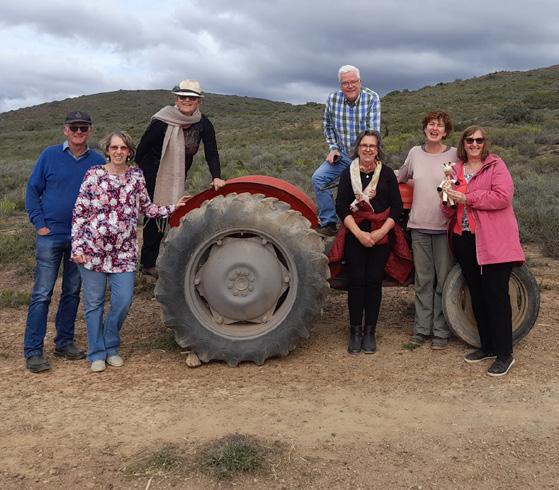
Outside of McGregor, one of those 6 degrees of separation expe riences brought us to visit a longtime friend of mine from Hazyview, Tina Bohm. Jen and Martyn met Tina when she was living in McGregor but she and her partner Andy, have bought a wonderful property outside of the village where they are building up a herd of Nigerian Dwarf Goats. Tina comes from a hospitality and tourism background and Andy is a Civil Engineer. Tina is the most amazing person who is
Main image: (L-R) Marlene Gracie, Jennifer & Martyn Johnson, MaryAnne and Chrissie Curnow - A wonderful day visiting the flowers in the West Coast National Park with “Winnie the Pooh” our travel mascot.


Left: Martyn & Jennifer Johnson, Marlene Gracie, John & Sue Lunder stedt, our host Tina Bohm, and Chrissie Curnow with our “Gerald the Giraffe” travel mascot. A day visiting Tina Bohm on her farm outside McGregor where she is growing a herd of Nigerian Dwarf Goats.
Far left: (L-R) Jennifer Johnson, Marlene Gracie, Sue and John Lunder stedt and Martyn Johnson - Martyn explaining the interesting spots around McGregor.
forever trying new things in life. An excellent cook with an entrepre neurial spirit, she is learning all about making cheese from the milk of these adorable little goats.
Since then, we have taken a longer trip of 3 nights to go and see the flowers in the West Coast National Park. What an amazing 3 days. The flowers were incredible. We visited Citrusdal, Paternoster, Vredenburg and Darling. A drive along the R355 – the longest gravel road in South Africa between two towns, making its way from Ceres to Calvinia. Along the way, you must stop at the Tankwa Padstal in the Tankwa Karoo for a refreshment and a delicious pub style lunch.
Each time we take a trip, we bring (well I bring along) a mascot. Sometimes its Winnie the Pooh, sometimes Piglet. As the Aussie in the group, next trip is going to be my Tasmanian Devil…
The purpose of the mascot comes from the fact that I have done a lot of travelling on my own, so he/she represents those we love and care for that are not with us on the journey. I see a lot of people take a mascot on their journeys – the internet is full of photos of people travelling with their mascot of choice. I had Piglet on a trip to the UK in 2019 and took a photo of him looking through the window of a cute shop that had Winnie and his friends having tea. I think the humans around me thought I was nuts!
We highly recommend you take a day trip to explore this beautiful part of South Africa in which we are so grateful to live. Sharing with new and old friends makes life a joy! Happy exploring.
5 The Stanford Spectator20 OCTOBER 2022
ADVENTURES
FUNDING IS VITAL
Writer: Lana Coates, Stanford Rotary


Serving a community can be an expensive business which is why fundraising to keep us going in our ongoing endeavours to assist others wherever needed is vital. We are so grateful for the gener ous folk who support us throughout the year.


With only around eight weeks left until our recess and the Christ mas holidays, we have several exciting fundraising events coming up, such as:
Art Morning: This is going to be great fun! Book now to avoid disappointment (only six spots left).


Sunset Market Raffles in October, November, and December: Stanford Rotary is known to have a raffle at the Sunset Market each month. We have lovely hampers to be won – wines, cheese, pork roasts, handmade items for the home, pamper packs for some downtime, and many other delicious things. You’ll find us at the Muni office end of the Village Green – just look for the Rotary flag.
Overberg Toy Run on Sunday 27th November: While not a Rotary project the organisers of the Overberg Toy Run have appointed Stanford Rotary as the official distributors of the toys donated, which are shared between surrounding Overberg towns. So come along to Birkenhead, relax in the sunshine, enjoy the vibe – all we ask is that you bring along a toy.
Hampers with Love in December: These are food parcels distrib uted to those who use the soup kitchens during the year. Our soup kitchens take a break over Christmas and New Year. More about this in November.
SAWS RAFFLE WINNER
Richard Bath, SAWS Chairman, holds the bucket of raffle entries while Stanford resident Megan Bezuidenhout draws out the winning ticket. The raffle was won by Charon Landman, who was overjoyed when she heard she had won a 16-piece Wonki Ware dinner set. We would like to thank all those who supported this awesome fundraising drive. All funds raised will go towards paying for SAWS monthly community clinic and vet bills.
ORANGE BLOCK UPDATE
The Stanford Heritage Committee (SHC) has raised a number of con cerns about a Draft Heritage Impact Assessment (HIA) for the proposed development of Erf 1772 which falls within a larger parcel of land, infor mally known as the 'Orange Block’.
The Erf was recently incororated into the 'urban edge', albeit, the Committee submits, with questionable public consultation having taken place.
Currently the zoning of Erf 1772 is for Agriculture Zone 1. However, the application for the proposed development will be for rezoning to General Residential to provide for some 91 residential units on small erven ranging from 210 to 314 m2 within a gated scheme. The scheme includes a security gate, private roads and private open space.
A key concern is that the draft impact assessment does not appear to consider the important precedent that is being set by Erf 1772, which could be repeated throughout the ‘Orange Block’, resulting in wall-towall gated projects and loss of the rural charm of the area.
The SHC notes that the entire area to the east of the R43, including the recently incorporated 'Orange Block' does not have a Local Spatial Development Framework (LSDF), or Precinct Plan, which is considered essential for guiding future development in the 'Stanford East' area.
Furthermore, the Draft HIA is considered to be “incomplete and in adequate” in its present form as it lacks reference to the legal planning framework, nor does it provide any heritage mitigation measures given the heritage significance of the area, including the cultural landscape and scenic routes.
The Stanford Spectator will be following this story closely and will keep readers informed of any updates. In the meantime, this link will provide useful information and guidelines:
INFORMATION & GUIDELINES
6 The Stanford Spectator 20 OCTOBER 2022
COMMUNITY
COMMUNITY & MUNICIPALITY
I WILL JOIN THE NAVY’ ‘WHEN I LEAVE SCHOOL,
Building skills and confidence in Stanford’s teenage boys . . .
Writer: Nelly Roodt
“I am terrified of water. There’s no ways I will go near the lagoon.” … The teenager was adamant. Growing up he had nearly drowned three times, he explained. He had just arrived at Wortelgat – as one of eight boys nominated to attend the joint Stanford CPF/ Wortelgat Outreach Trust weekend getaway in Septem ber. Two days later, following planned activities tailor-made to build self-confidence, develop skills, and explore potential, his fear had dissi pated. Partnered by a Wortelgat facilitator, he was in a kayak, ready to row. “I will be joining the navy when I leave school,” he beamed.
The weekend getaway for the teenagers, which took place from the 23rd to the 25th of September, followed Overberg District Munic ipality’s request to the Stanford CPF to submit a youth project proposal for possible funding.


The CPF had long since identified the need for mentorship for underprivileged youth in the community. The district municipality’s offer for funding had made it possible to design and execute a pilot project to address the need.
Wortelgat Outreach Trust was delighted to become involved. “This is exactly what we do,” Wortelgat Outreach Trust manager Owen Hendriks said.. “Our passion is to create worldclass, Christian-based camping experiences through innovative planning, stunning ameni ties and the use of our breath-taking position on the banks of the Klein River at the lagoon.”
So, it was off to Wortelgat. Stanford Security provided transport to and from the venue.
Seven team leaders in supervisory positions looked after the boys: CPF project co-ordinator Anchelle Damon chaperoned the energetic, curious teenagers – ages ranging from 14 to 16. Owen and his wife, Salome, Wortelgat programme manager Nadia Mos, and camp facilitators Migael Visser, Deané Pedersen and Marlin Abrahams presented the experiential learning.
Of course, the minutes, hours, and days were action-packed. Overberg District Municipality’s funding made provision for all the high-energy requirements for meals and snacks – catering specifically for youth-driven appetites.
Post-intervention interviews with the seven team leaders indicated that despite the limited time available, the boys came together and supported each other. They developed thinking and planning skills individually and as a team, and through self-reflection activities recognised their own capabilities.
SAPS station commander Capt Blanche Da vids, visiting the camp over the weekend, gave her stamp of approval.
It was over far too soon. “Why can’t we stay for a week?” the boys asked. Revitalised and with undertakings to respect their parents and to do their best at schools, they were assured that Stanford CPF and Wortelgat Outreach Trust would undertake further development projects with them for the foreseeable future.
The CPF vision is to assess the project suc cess over time and to secure more funding for further youth development.
CLEANING UP OUR BEACHES KEEPS OUR OCEANS HEALTHY
Overstrand Municipality’s Environment Management Section joined countries from across the world to mark International Coastal Clean-up Day.

The clean-up was held on the 15th of September 2022, and the team cleaned up the beach between Grotto and De Kelders. A total of 36 bags and two bakkie loads, with a total weight of 427.5 kg, of waste and litter were collected along the 14km of beach to minimise the amount of rubbish in our oceans.
Plastic containers, fibre installation pipes, fishing net and net pieces, kreef and chokka traps, wood pallets, bubble wrap, a 6-man tent and pieces of rope (54 meters long) were picked up. An ordinary plastic container can take anywhere between 50 and 100 years to disintegrate as it is not biodegradable. Alarmingly, since it’s advent in the 1950’s over one billion tons of this type of plastic has been discarded. The scourge of plastic is only increasing. It is necessary to keep our beaches clean if we hope to keep our oceans clean.
Overstrand Municipality once again thanks residents for donating their time and energy to clean our beaches.

7
KEEP LITTER
OFF OUR
BEACHES AND
OUT
OF THE SEA:
Environmental
officers,
field rangers and EPWP
workers from
Overstrand Municipality’s
Environmental Manage ment Services
(EMS)
took
time out
to
collect and picking
up litter from
our beaches
earlier in
the week. Municipal Manager: Dean O’Neill | Tel: 028 313 8003 mm@overstrand.gov.za | Overstrand Municipality
CLOCKING IN FOR SAKEnature’s
If you have a love of nature, a camera or even a cellphone and access to internet – you are in demand. Or rather, you will be later this month from Friday the 28th of October until Monday the 31st of October.
Your date with nature is all about the Over strand’s participation in the Great Southern BioBlitz (GSB), for the second time this year.
So, what is BioBlitz? It is an international period of biological surveying undertaken by the public in an attempt to record all the living species across the Southern Hemisphere in a short window period.
Says Councilor Clinton Lerm, Mayoral Committee Member of Investment & Infra structure: “The BioBlitz involves listing all
species that occur in the Southern Hemisphere in spring on iNaturalist.org. We want to share our fantastic biodiversity with the world, and with your help, your data becomes part of our collective knowledge of what occurs here and where, and this information can be useful to scientists in many ways.”

Plants, mammals, birds, insects, reptiles, marine life, fungi, etc., that live within the boundaries of Overstrand Municipality are all snappable. The easiest way to start is on your doorstep - in your home and garden (species do not have to naturally occur), and then go hiking in the area (sidewalks, vacant lots, mountains, and sea). Do remember to look in the air and under the ground too.
The To-Do List
• Upload photos to www.iNaturalist.org or use the free iNaturalist app.
• Try to take clear photos above 1MG - this helps the experts with identification.
• Take photos from different angles.
• With plants, take photos of flowers, leaves and fruits or seeds, growth habit and habitat.
• With insects, take as much as possible of the whole body. Take from above and from the side.
• Extra detail like the antennae, eyes and legs also help. Look at what your bug is sitting on and what it’s doing.
SPECIALIST KNOWLEDGE ALSO WELCOMED
How To Participate
• Download the iNaturalist app or visit www. inaturalist.org and get ready to take heaps of photos of every living thing.
• Sign up for the GSB 2022 Overstrand project and follow them on Facebook: Overstrand BioBlitzing. Or click here:

OVERSTRAND BIOBLITZ
This year the Overberg is also participatingthe link to their project is:
Sandy Immelman of Betty's Bay Conservancy, and one of the Overstrand’s BioBlitzing Organ isers for 2022, asks for assistance with regards to the identifying the observations post the BioBlitz.
She said there are 10 days for people to help with identifying the observations and this is critical in order for the data to be relevant for scientific purposes.
“Anyone who is a specialist in any field pertaining to flora, fauna, fungi, etc. is requested to do as much identifying as pos sible during and post the GSB - which often can include people who either weren't in the area at the time, or cannot get out to take photos, but have valuable knowledge that can really make a difference,” she requested.
OVERBERG PROJECT
The idea is to show off the incredible biodiver sity in this special part of the world. Let us help make our biodiversity world famous.
Oh, and just a thought, Monday the 31st of October is Halloween’s Day – so watch out for the pumpkins!
8 The Stanford Spectator 20 OCTOBER 2022 ENVIRONMENT
for conservation
Writer: Anneline Ferreira

Living where we do, tucked between the mountains and the ocean, it is impossible not to be intensely aware of the environ ment that surrounds us. Conservation in Stanford is already a big issue, but to go beyond that and be part of a body which champions the cause of protecting the natural environment on a global scale has become essential.
Birdwatching or ‘birding’ is probably the fastest growing and most easily attained, yet most underrated leisure activity in the world today. Not only does it enhance the quality of our lives, but it creates awareness and supports conservational efforts like few other pursuits.
Stanford Bird Club was established in 2004 and today consists of 50 members, from beginners to professional experts. A smaller club compared to most, we are affiliated to Birdlife South Africa which allows us contact with some of the most prominent birders in the country and affords us the opportunity to
actively support their conservation efforts.

On our monthly outings through the Overberg, we are privileged to visit a variety of habitats from mountain passes, through wheatfields, down to the coastline. Each destination is carefully selected for the best birding opportunities according to the time of year.
The OCTOBER outing which will include PLATBOS indigenous forest between Stan ford and Gansbaai provides another chance to go Beyond Birding, our focus for 2022/23, and support their efforts to protect this endangered ecosystem.

Regular evening talks by seasoned birders or environmental activists are most informa tive and entertaining. Impromptu outings or an annual getaway where we spend a few nights away, add to the colour and pleasure of our activities.
Why NOT join the club?
An annual membership fee of R200 ap plies, plus only R50 for a spouse/partner.
To join or for more information, email annelineferreirapta@gmail.com

9
The Stanford Spectator
BIRD TALK
FLYING HIGH
083 251 1361 TRANSPORT24 Overberg to Cape Town Transport Service Richard Walter 083 251 1361 083 380 3235 ##minimovers#overbergtransport Transport24 #shuttle24 #howcanwehelpyou Richard Walter Bath #Transport24 #overbergtransport #minimovers #shuttle24#howcanwehelpyou#loadshare Free Online Daily Zen-Meditation www.BornastheEarth.com Right here in Stanford To place an advertisement, please contact: Melissa Mc Alpine 078 324 5692 melissa@stanfordnewsagency.co.za
OUT & ABOUT ON OUR DOORSTEP
 Writer: Anneline Ferreira
Writer: Anneline Ferreira
Looking out at our surroundings it is unreal to imagine that just 14km away lies a relic forest; botanically unique, rare and endangered.
Platbos, Africa’s southernmost forest, is one of the few surviving indigenous forests in South Africa and is filled with ancient trees, some of which are over 1000 years old. It is only through donations that this endan

gered ecosystem can be protected, and the biodiversity conserved; a myriad of life forms that include mosses, lichens, birds, insects, bushbuck and honey badgers. Platbos is also an important habitat for the endangered Western Leopard Toad.
More than 150 species of avifauna have been recorded at Platbos, and many species present quite the challenge in spotting them as they are some of the most elusive. You
will hear them, but try finding the terrestrial brownbul, sombre greenbul, olive bushshrike, blue-mantled crested flycatcher, woodpeckers, the common quail or buff-spot ted flufftail. Even the names sound like they belong in a fairytale.
The forest trails frequented by wildlife and tree enthusiasts afford an opportunity to satisfy more than just the love of nature – it is indeed therapy.
10 The Stanford Spectator 20 OCTOBER 2022
Magic
INTRODUCING
STANFORD BUSINESS FORUM
The Stanford Business Forum was formed with the specific aim to support and pro mote local businesses and entrepreneurs through an Economic Development Strategy driven to achieve sustainable and inclusive growth of our local economy as a connected community within the Stanford Valley.

The key focus areas include:
• To foster, promote and facilitate an environment in which local business es can interact and work together in collaboration for mutual benefit.

• Providing a conduit and being a voice representing the views and opinions of businesses in the Valley.
• Ensure that the views of local busi
nesses are taken into account when any Agency, National Government, Local Authority or any other institu tion is reviewing policy, legislation or simply seeking the views of the wider Stanford Valley business community.

• To ensure we create a platform that includes socio-economic growth that fosters and serves the need of the broader Stanford Valley community.
• Research and communicate relevant information that would maximise the opportunities for businesses, both formal & informal, in the Stanford Valley.
• Seek and communicate any funding, training, and marketing opportuni
ties available to businesses in the Stanford Valley.
• Strategise marketing opportunities, as a collective, of the products & services offerings within the Stanford Valley.
This initiative will be launched formally on the 2nd of November 2022 – details will be made available closer to the date.
However, should you require additional information, please do not hesitate to contact the team on info@stanfordbf.org
11 The Stanford Spectator20 OCTOBER 2022 ADVERTORIAL
HAVE YOUR SAY LETTERS
STANFORD ARTISTS
THE BEST!
An amount of R28 147.50 was made as a result of the many artists in Stanford who gave so generously of their time and talent. Funds raised through this initiative went to Stanford Conservation who were celebrating their 30th Anniversary in Stanford. My sincere thanks goes out to each one of you for participating in this fundrais ing event.
Also included in this fundraiser was a raffle for four beautifully framed original pictures donated by local artists along with a Craft Table selling local items. Thank you to all the helpers manning the various areas in the Egret and Owl restaurant and for receiving the money when paintings were sold.
A big thank you to Annalize Mouton who gave us the use of the Egret and Owl venue, which was the perfect setting for the artworks to be displayed. Annalize also donated the painting by Dawid Toua, which we put on display and sold on a Silent Auction raising R5 500.00. A magnificent effort from all involved.
– Sarah James
ED: It certainly takes a village!
TO GENERATE,
GENERATE?
I would like to get the public’s opinion on the use of generators in Stanford. I’m currently dealing with a complaint lodged against a friend whereby the municipality has sent them an email with a report from an independent contractor with reference to West ern Cape Noise Control regulations, PN 200/2013.
– Gavin Horne
ED: Keep an eye out for our next issue, Gavin, where we will try and get some answers for you.
TOADS A BREAK!
While riding my bicycle around the village, I’ve been noticing lots of squashed toads and birds on the roads. Please be careful when driving your car in Stanford, our animals are an important part of our village too.
– Kristen Absil
ED: Kristen, you are so right. We should all be taking note of what crea tures are becoming victims to speed.
A BIG THANK YOU
& AH YES! THAT GROCERY STORE ISSUE AGAIN …
Congratulations on a spectacular issue. Thank you for the PDF version, which I personally find more readable than the online version. The print version is sure to be very popular with visitors to our village.
On another note – one really wonders why all the secrecy surround ing the grocery outlets? The ladies working for TOPS have told us on two occasions Spar will only open next October! For now, they are first expanding the bottle store. If you ask me that decision cannot be based on any market research as to what the village needs.
– Susanne Terry
ED: Yes, we’d like an answer to that one too. Regarding our publication, a print version is now available. It’s even better than the PDF!
LIFE IS A HIGHWAY … SO IS OUR R43 IT SEEMS!
Since the completion of the R43, some drivers have become a bit brazen as they drive the stretch of road between Hermanus and Gansbaai. And while these drivers may think they have a ticket to ride (pretty much as fast as they like), residents living close to the R43 are not enjoying the disruption to the peace and quiet as cars whizz past at high speed. Then there’s our wildlife too that needs considering - toads, moles, tortoises, porcupines and baboons are ending up as roadkill because they can’t get across the road quick enough before being run over. Main roads going past residential areas like Hermanus, Kleinmond, Hawston, etc., all have a reduced speed limit of 60kms for quite a stretch, yet here in Stanford only a short stretch of road, just around the traffic circle itself, is 60kms while the rest of the road is 80 – 100kms. Perhaps an analysis could be done to gauge consequences the new road is having on our residents - and wildlife - so that necessary measures can be put into place?
– A concerned resident
ED: While we are so grateful for the new (and improved) road, noise pollution is a real concern as is our precious wildlife.
welcome all
that
an
have
to:
12 The Stanford Spectator 20 OCTOBER 2022
GIVE OUR
We
letters, comments, and suggestions. If you
something
you’d like to say, please send
email
Liz Clarke: liz@stanfordnewsagency.co.za, or Melissa Mc Alpine: melissa@stanfordnewsagency.co.za – YOU ARE
OR NOT TO
EGGCELLENT EGGS
Writer: Liz Clarke
Getting to the Georgiev’s free range egg farm, home of Eggcellent Eggs, in the hills above Pearly Beach is a bit of a roof of Africa expe rience. The roads are windy and narrow, and you are never quite sure if your GPS is telling the truth. However, once you have negotiated the last few bumps of sandy track you will see the chickens – hundreds of them, white with red topknots, running free, pecking the ground or at their troughs – and not a battery insight.
Somewhere in the midst of this chicken menagerie, you will find Terry Georgiev, one time Pick n Pay IT supervisor, now a hands-on producer of free-range eggs.
“Packing day!” she says introducing us to team member Hawa who is cleaning and pack ing the eggs in trays for each coop, to establish that day’s production.
Terry and her Bulgarian-born husband, Sa sha, have been nurturing their free-range egg business on this isolated piece of real estate for the past six years, creating safe havens for their pasture-raised chickens that produce eggs with bright, picture-perfect, yellow yolks.
“We both love farming and before relocating to the Overberg we had our own small garlic
growing business near Paarl,” she says, her thick wellies and tanned arms telling you that doing it themselves is part of the deal. “For us our new venture to supplement our income had to be something that didn’t involve chem icals, GMO feeds, didn’t destroy the natural surroundings and was kind to farm animals. Free range eggs ticked all those boxes.”
They started with 40 hens and three roosters, typical farm chickens, which they purchased from the previous tenant and con verted the pig pen into a chicken coop and the humble beginnings of Eggcellents was created. Within a short space of time, they had bred and raised their own flock to just over 1000 chickens of various ages.

As word got out about their eggs, it wasn’t long before there was a demand. With savings that Terry and Sasha had accumulated from their fresh produce marketing enterprise, they were able to buy their first batch 300 layers early 2018.

“This is what you will need if you really want to have an egg production”, says Terry. “Production was well over 95% and some days 100%”. We made a decision to only have proper layers, as having dual purpose breed’s like Koekoek, Astralorp and Rhode Island reds
will eat you out of business. They get broody and if you lucky get three to four eggs a week from one hen, whereas layers will give you six to seven eggs in a week.
Today they have over a 1,500 Amberlink / Silver Hyline layers which produce approxi mately 1 300 eggs a day. Sasha’s carpentry expertise enabled them to build three mobile coops and custom-made roost and egg laying boxes.
When lockdown came which wasn’t good for many businesses. “A lot of our private customer bases, lodges, hotels, B&Bs etc., disappeared almost overnight. What on earth were we going to do with all our eggs?”
It wasn’t long before the couple came up with answers.
“We both believe positive energy is the only way to keep dreams alive – even during tough times. We found alternative outlets further afield, which meant that we could sustain what we were doing.”
Relocating young battery chickens is a big part of their farming enterprise.
“We buy at least 300 points of lays every 3 to 4 months, bring them to the farm where they are rehabilitated to their new surroundings. We give chickens a life and to be able to do
13 The Stanford Spectator20 OCTOBER 2022 FARMING
Terry Georgiev and her team understand the compassionate side of rearing pasture-raised chickens and free-range egg production.
chicken things, like sand bathing, running after bugs and getting good fresh air and sunshine”.
Do chickens have personalities?
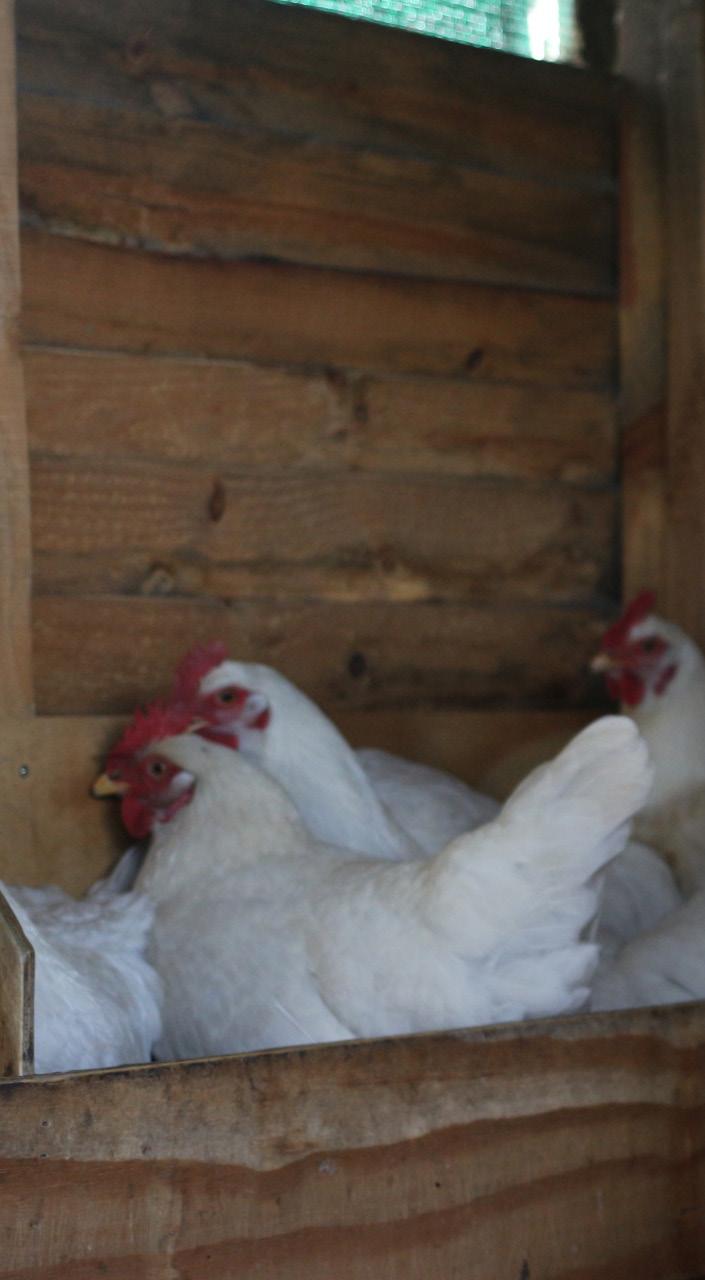
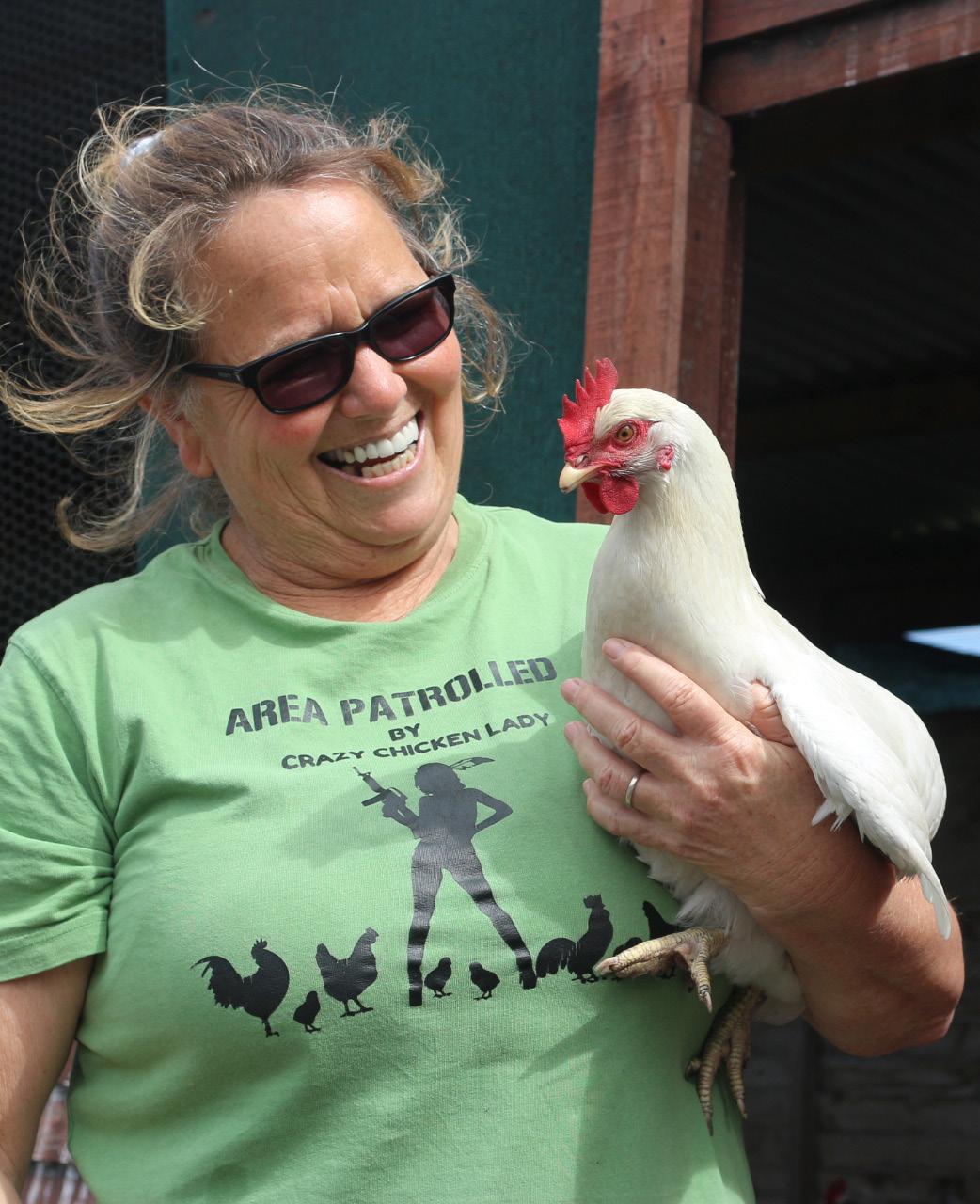
“Yes, absolutely they do,” says Terry. “Some are loud and cheeky, others are more timid, but they all respond to kindness. I talk to them all the time. Often, I sing, and they come to me.”
Even more amazing, when Terry does her predator alarm call – a loud persistent high-pitched sound – every chicken in sight runs for cover.
“When I say it’s all clear – everything is OK, they come out. And when they do, they all look up at the sky just to make sure.”
Terry, Sasha, their chickens and the Georgiev farm team including three rescue dogs Zigi (Great Dane), Diesel (Border collie) Mizo (American Staffie) and two Maine Coon cats, Vladimir and Al Pascal, will shortly be relocating to a new farm on the Pappiesvlei Road, just outside Stanford.
So, watch this space!
Uses for Eggshells
Did you know that there are so many uses for eggshells?
From human supplements to fixing your soil. Here are a few ideas to get you eggcited about eggshells:

• Use eggshells as a calcium and mineral supplement.
• For human or pets, wash the shells thoroughly to remove any egg residue, bake at 180 deg Celsius for 10 minutes, then crush using a pestle and mortar to a fine powder. Add a teaspoon to your smoothies or sprinkle over food.
• For wild bird or chicken feed, wash and crush the eggshells and add to their feed.

• Helps reduce any bitterness in coffee.
• Add them to ground coffee before brewing. Wash the shells thoroughly to remove any egg residue, dry, then crush and add to your ground coffee, brew.
• Soil additive for houseplants.
• Crush the shells and to your soil which will add miner als and help keep soil loose and aerated.
• Add to your garden.
• Crush the eggshells coarsely and add to your garden. It deters and repels slugs, snails, and cutworms without resorting to toxic chemicals. Mineral-charged eggshells can be crushed and scattered into each hole before planting. Sprinkle additional crushed shells around your plants every couple of weeks. Use them to start your seedlings!

14 The Stanford Spectator 20 OCTOBER 2022 FARMING
WHAT’S BLOOMING?
A ROSE BY ANY OTHER NAME
Earlier this month, one of Stanford’s keen gardeners, Johan Schoeman, shared his love of gardening and his personal journey with roses.

A SUCCESS STORYblooming
Writer: Liz Clarke
Proteas might struggle to survive in Stan ford, but roses will – as long as you choose the right ones and stick to the basics. These are the home-grown thoughts Johan shared with fellow gardeners during a springtime get together at one of the village’s beautiful riverside homes, alive with indigenous flowers bountifully infused – you have guessed it with roses of every type, colour and description.
“Roses have a lot of stamina, more than most people think,” says Johan (pictured left). “They don’t mind wind and cope well with heat.”
His choices for Stanford are roses that grow well in all kinds of soil, provided they are given the right start of position, soil, slow-release granules, water, top dress ing, regular dead heading and adequate drainage.
“I would put Deloitte & Touche at the top of my shopping list. If you planted now, they would be blooming by Christmas especially
Below left: Great for Stanford - the deco rative and fast-growing Deloitte & Touche rose produces many full bloom clusters and grows well if planted in pots in the full sun. A bee-attracting rose, it has a lovely fruity fragrance.
if you put them in big pots. Another of my favourites is Arctic Ice, a beautiful hybrid tea that needs space to develop. It is impervious to fungal diseases, a strong grower, and bears masses of fragrant mauve roses of near perfect shape all season long.”
And do not forget South Africa’s most popular rose, the white Iceberg, which he says you should prune only lightly because its flowers from the previous season’s growth. It flowers profusely year after year without too much attention.
The trend today, he says, is a return to fragrant roses with the old-world shape of yester year.
Large growing roses that do exceptionally well in Stanford are Guililah, Addo Heritage, Morning Star and Marshmallow Panarosa.
David Austin roses that do well here are Heritage, Desdemona and Golden Celebra tion. Good climbers: Crème Caramel, New Dawn and Perfumed Breeze. Floribundas that have proven themselves are Deloitte and Touche, the Granny’s and South Africa. These floribundas will also do very well in containers.
Here are some of Johan’s home-spun tips about growing roses:

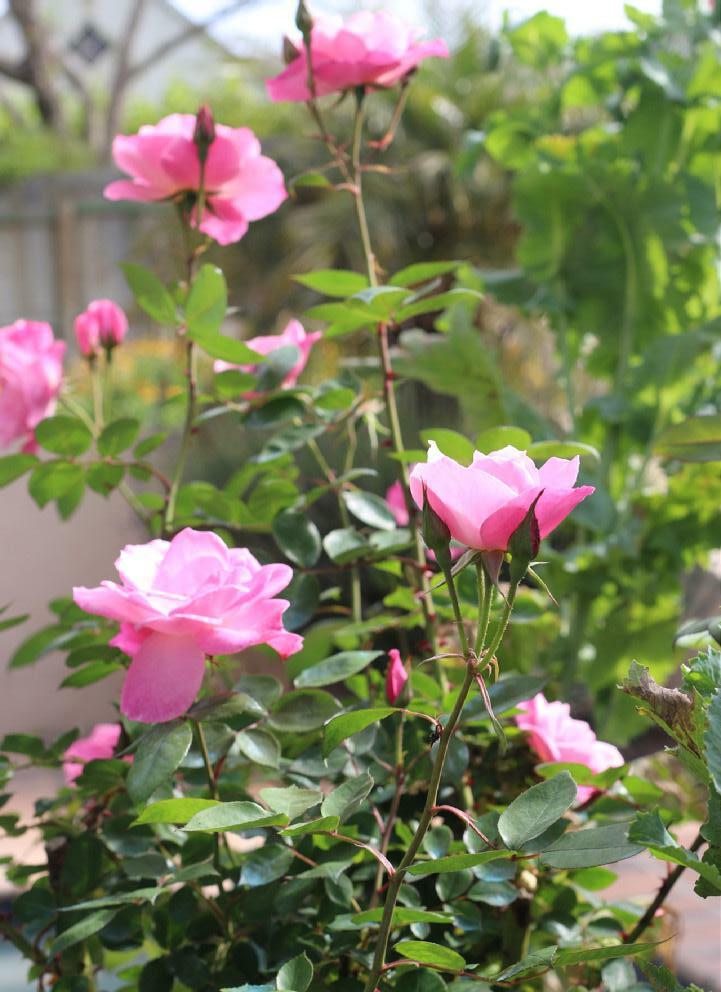
• Select roses that are known to do well in a Mediterranean climate with high humid ity. These include roses that are bred to withstand fungal diseases and need the minimum amount of spraying. These ros es are marked as “Echo-chic” in the rose catalogues and some with exceptional vigour are marked as “stamina” roses.
• Avoid planting roses against a white wall because of the sun glare or near any inva sive root system. Plant where the flowers can face the sun for at least 6-8 hours per day.

• Make sure the ground around roses is covered, either with an organic material or a “green” ground cover like alyssum which helps retain moisture
• Always remove the end of flowering hips to encourage new flushes of flowers.
• And here is a nice one to think about –gardening is good for emotional, physical and spiritual wellbeing. Being among plants stimulates a chemical substance that offsets anxiety and depression and enhances creativity.
Funds raised by The Stanford Garden Club will go to the Die Kop Zizimelani Food Garden to support their projects.
15
The Stanford Spectator20 OCTOBER 2022
TEAMWORK MAKES THE DREAM WORK…
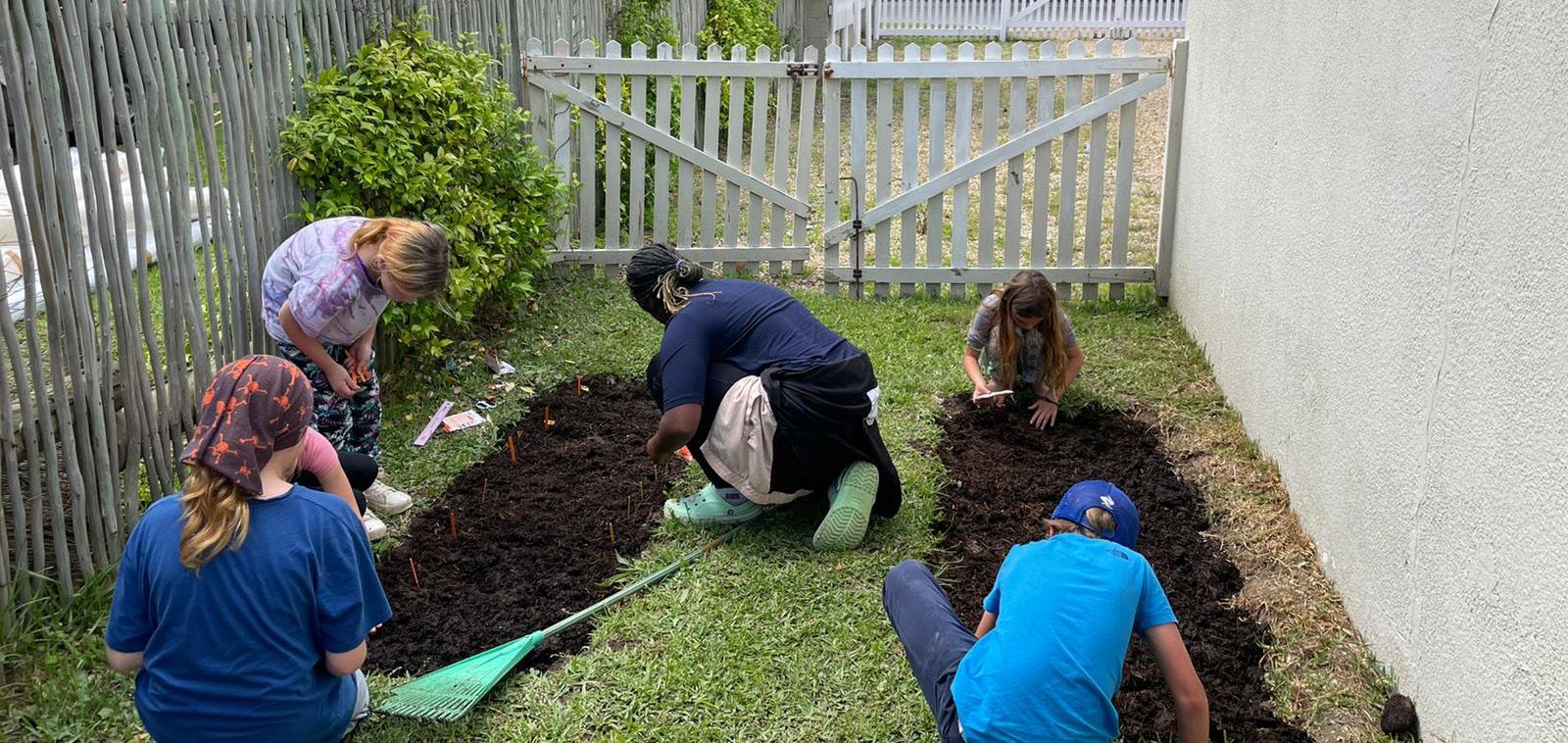

Eduden parents have been sprucing up the play area of the school. Headed by interior designer and painting wizard, Marlene, parents and an Ouma have spent hours sourc ing materials, painting, planting, and constructing things to take Eduden’s playground from good to great. From a new mural to soccer goals, seating and board games, our play area is now a fun place for our kiddos to hang out and spend time. A big THANK YOU to all those parents who went the extra mile by sponsoring various items, from sand, stone and plants to tyres, paint and building materials. We appreciate all the time and effort that our parents put in to really make a huge difference to our ‘Edudenners’. And an extra special thanks goes out to our project manager, Marlene, and to Ouma Nicolette for being absolute garden whizzes.

16 SCHOOLS
KEEPING A VERYclose watch
658 SOUTHERN RIGHT WHALES IN OUR WATERS
It took just under 21 hours of flying time to conduct the 43rd aerial survey of the southern right whales that annually visit South African waters. The survey from Nature’s Valley to Muizenberg was conducted from October 1 to October 5 by the University of Pretoria’s Mam mal Research Institute’s Whale Unit, using an AS350 (Squirrel) under charter from Silvercoss Helicopters.

During the survey all cetaceans were recorded with a special focus on southern right whales. Photographs were taken of all southern right whale females with associated calves, as well as of all with a brindle, grey or white blaze colouration.
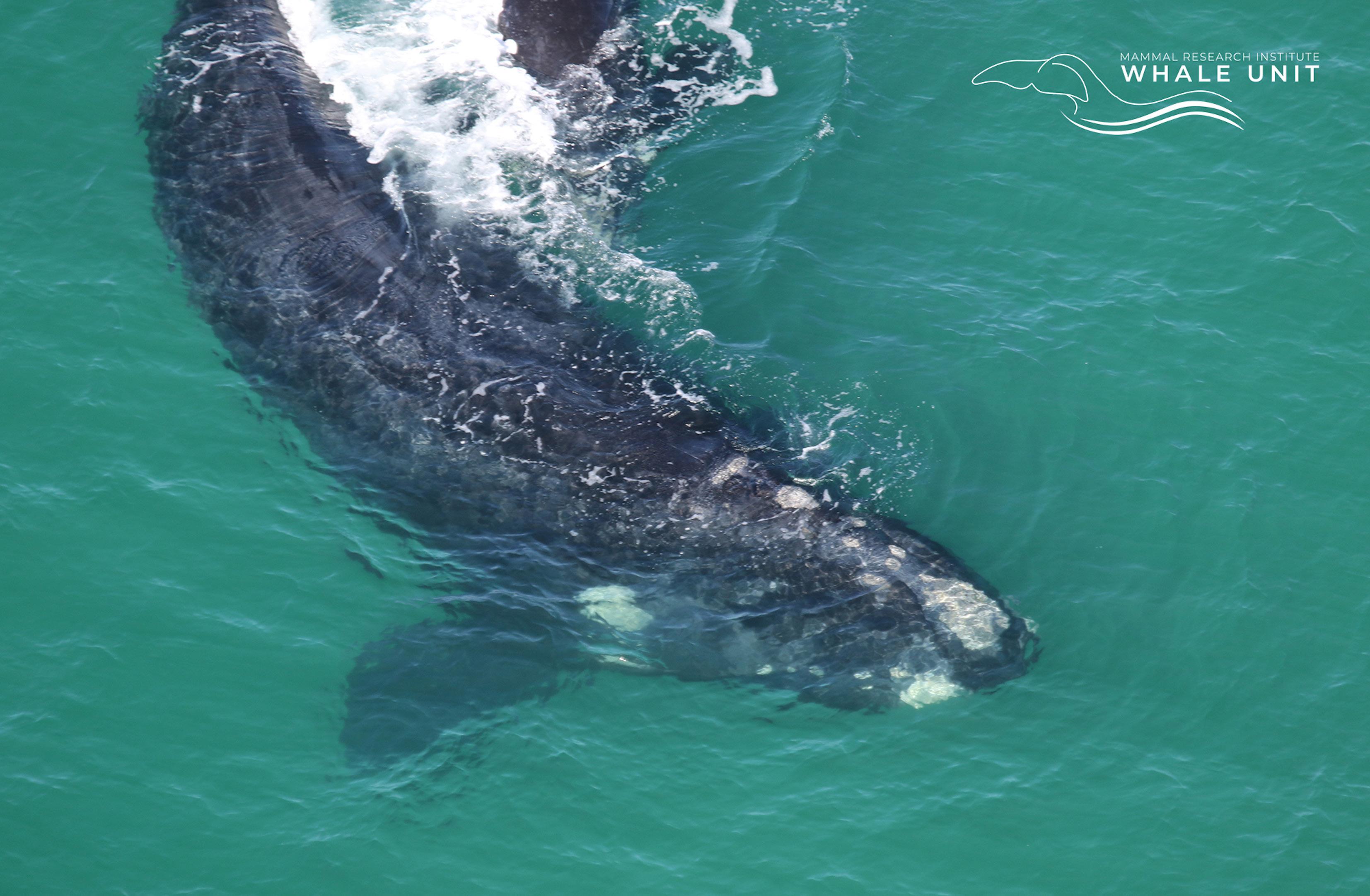
During that time, 304 calving females (i.e., with an associated calf; 608 whales) were counted and photographed, as well as 50 adult whales without a calf (so-called ‘unaccompa nied adults’), bringing the total to 658 southern right whales between Nature’s Valley and Muizenberg.
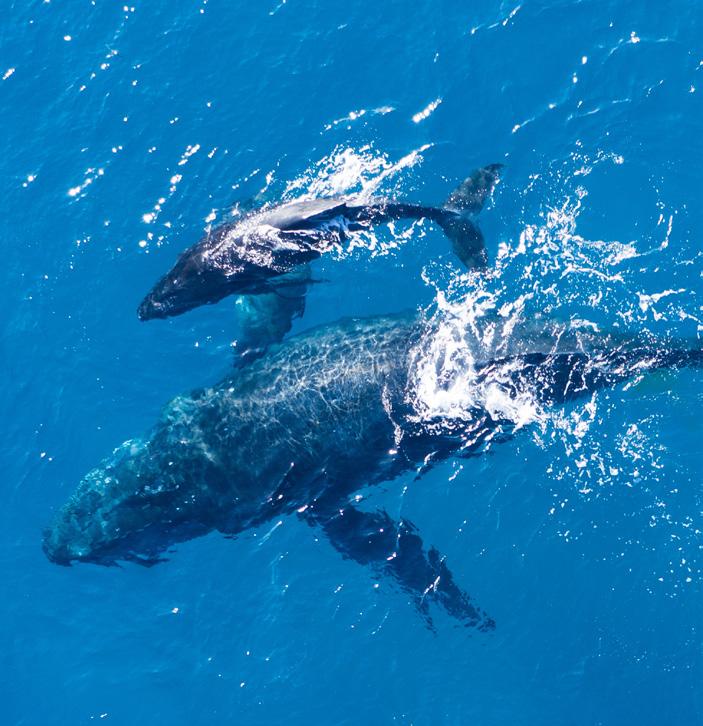
As in the past decade, the number of ‘unac companied adults’ (UA; males and non-calving females) continues to remain extremely low, indicating that they are still not migrating to the South African coast at the same rate as they used to.
A total of 15,116 photographs were taken during the survey for photo-identification pur poses. These images are currently being sorted
and organised so that they can be analysed for identification of individual whales using computer-assisted image recognition system, followed by final confirmation, and matching of the whales by eye. Through such analyses, we will be able to determine which females calved this year, how long it took them to produce a new calf, their individual distribution and movement patterns and, with considerable ac curacy, assess their overall productive success.
These aspects are vital to monitor the re covery of the South African population of right

whales, which has been increasing at a rate of 6.5% per year since the international protection of the population from whaling. These analyses will also allow us to investigate further possible causes and consequences of the concerning decrease in sightings along our shores in recent years.
This report was compiled by Whale Unit Re search Manager Dr Els Vermeulen and Whale Unit Technical Manager, Chris Wilkinson.
17 The Stanford Spectator20 OCTOBER 2022 COASTAL WATCH
Gardening Guide
FOR OCTOBER / NOVEMBER
This page is sponsored by Seeff Stanford.

It’s that time of year when roses are open ing, and plants are beginning to show their true colours and potential. Also known as the ‘month of the rose,’ October truly is one of the most beautiful months of the year in terms of gardening, and so is November.
Some top tips to keep your garden in tiptop shape this month:
• Make your own compost, turn it occa sionally and keep it slightly moist.
• Mulch your garden while the ground is still soggy after the rain.
• Prune fruit trees and shape citrus trees.
• Sow summer flowering annuals like mari golds, cosmos and sunflowers.

• Add fertilizer to lawns to give it an extra boost.
• Feed your regularly-flowering plants such as daylilies, fuchsias, cannas and roses.
• Prune early summer flowering shrubs like philadelphus, Cape may, and mock orange.
• Tidy up winter flowering succulents and replant their babies elsewhere.
• Keep garden bugs at bay by using eco-friendly pesticides.
• Remember to be water-wise!
• Weed the garden to eliminate unneces sary competition for water.
• Prune Fynbos-type plants to stimulate new growth.
VEGGIES TO PLANT: Beans Beetroot Broccoli Cabbage Carrots Celery Cucumbers Eggplants Lettuce Maize Okra Peppers Pumpkins Radish Squash Sweetcorn Sweetmelons Swisschard Tomatoes Turnips Watermelons
HERBS TO PLANT: Basil Coriander Chives Chamomile Echiacea Lavender Oregano Parsley Rocket Thyme Watercress
FLOWER SEEDS TO PLANT: Alyssum Antirrhinum Aster
California Poppies Candytufts
Carnations Canterbury Bells Chrysanthemum Cornflowers Cosmos Dahlia Dianthus Felicia Forget me nots Foxgloves Gazania Gerbera Gypsophyla Helichrysum Hollyhocks Impatiens Marigold Nasturtiums Pansy Petunia Poppy Portulaca Sunflower Sweet Williams Verbena Zinnia
18 The Stanford Spectator 20 OCTOBER 2022 GARDENING
COMPETITION WIN A FLOWERS OF SA 2023 CALENDAR Stanford News Agency is giving away two SA Flowers 2023 calendars! To enter, SMS* your name, email address and answer to the following question to 078 324 5692. Question: October is known as the month of what flower? Clue: The answer can be found some where on this page. *Normal SMS rates apply.
Full sun Full Sun / Semi Shade Shade Semi Shade Shade / Semi Shade KEY:
LAST WORD
MARTIN RANGER HAS A BIT OF FUN WITH . . .
AUTUMNN OAKS AND MERCURY RISING
Recently, I celebrated a significant birthday – a date that sits within a few days of music legend Freddie Mercury’s anniversary. Now Freddie was born in boring old Zanzibar, while a few days earlier I had made my theatrical debut at a cottage hospital in exotic Wilt shire. Later, Freddie donned sparkling trousers and tight vests whilst my attire followed the grey and white of corporate uniformity. As Freddie and his fellow roy als routinely climbed the charts, I pulled myself up the career ladder, avoiding a few snakes on the way.
Unlike Freddie, who sad ly didn’t make it to retire ment age, I’m still gratefully drawing my pension from both Queen (Consort) and Company. And thanks to some regular maintenance, I seem to be doing all right. That includes an occasional visit to my dentist, one that inevitably results in a contribution to his retire ment funding. Whilst sitting in the waiting room last month, I paged through a magazine. My attention was caught by an advertise ment for a new retirement village – Autumn Oaks.
Now, you know this style of ad - it features a handsome couple in their mid-fifties sitting in the cockpit of a racing yacht. He, tanned with a Hollywood smile, and she with her blonde locks billowing in the briny breeze. I assume that when they aren’t tacking their ten-metre boat across the limited confines of the village’s ‘trout-filled dam,’ they fill their days avoiding the line-dancing classes and ‘fun-packed quiz nights’.
I decided to accept the promotional offer to visit and observe the delights of a different village life, eventually completing the post visit questionnaire. I received a prompt response from the village’s manager:
‘Dear Mr Rangler (sic)
Thank you for taking the trouble to give feedback on your recent visit to The Autumn Oaks Lifestyle Village. Yes, you are quite correct in that the Lifestyle Centre has yet to be completed. However, I am pleased to hear that you visited the first phase – The Baby Boomer Clubhouse. I note your comment regarding the dubious authen ticity of Pierre’s Saint-Germain Bistro and accept that gingham tablecloths and candles in old Tassies bottles do not completely disguise Pierre’s Boksburg culinary heritage. However, I must point out that his spaghetti a la papa is a firm favourite. As to the fate of the library, gym and thirty metre heated swimming pool, please
be assured that these will all be included in Phase 3 of the project (subject to Life Right sales). In the meantime, our residents enjoy the Sell or Swop bookcase and, in case you missed it, the exercise bike that is located just outside the Acorn Tavern. I trust this answers your concerns.

Yours…’
Oh boy, Freddie, what you have missed! And, as you wrote: ‘Is this the real life? Is this just a fantasy?’ Well, I guess you know the answer to that one now, don’t you?

19 The Stanford Spectator20 OCTOBER 2022
SIR






ROBERT STANFORD WINE ESTATE, STANFORD BREAKFAST, LUNCH, SPECIAL EVENTS KIDS PLAY AREA, WEDDINGS, PRIVATE FUNCTIONS OPERATING HOURS: TUESDAY TO SUNDAY 09:00 - 16:00 072 412 6017 028 341 0647







































 Writer: Anneline Ferreira
Writer: Anneline Ferreira






























